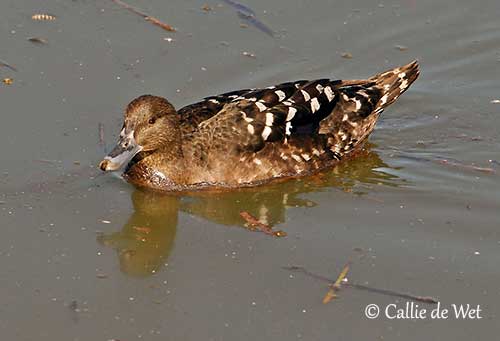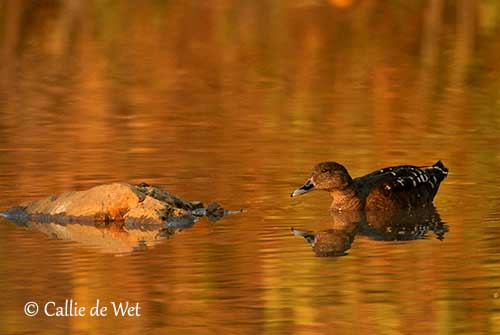
Fr: Canard noirâtre
Ang: African Black Duck
All: Schwarzente
Esp: Ánade negro
Ita: Germano nero africano
Nd: Afrikaanse Zwarte Eend
Sd: afrikansk svartand
Photographers:
Callie de Wet
GALLERY
Steve Garvie
RAINBIRDER Photo galleries & Flickr Rainbirder
Ken Havard
My Bird Gallery & Flickr gallery 1 & Flickr gallery 2
Text by Nicole Bouglouan
Sources :
HANDBOOK OF THE BIRDS OF THE WORLD vol 1 by Josep del Hoyo-Andrew Elliot-Jordi Sargatal - Lynx Edicions - ISBN: 8487334105
GUIDE DES CANARDS, DES OIES ET DES CYGNES – de Steve Madge - Delachaux et Niestlé - ISBN: 2603013769
BIRDS OF AFRICA SOUTH OF THE SAHARA by Ian Sinclair and Peter Ryan - Princeton University Press Princeton and Oxford - ISBN: 0691118159
BIRDS OF EAST AFRICA vol 1 by C.A.W. Guggisberg – Mount Kenya Sundries Ltd. – ISBN: 9966889051
ROBERTS BIRDS OF SOUTH AFRICA by G. R. Mc Lachlan and R. Liversidge – The Trustees of the John Voelcker Bird Book Fund – ISBN: 0620031182
Biodiversity Explorer – The Web of Life in Southern Africa
Wikipedia, the free encyclopaedia
THE AVIANWEB - Beauty of Birds (Sibylle Faye)
Territories and local movements of African Black Ducks
African Black Duck
Anas sparsa
Anseriformes Order – Anatidae Family
INTRODUCTION:
The African Black Duck has blackish brown plumage overall giving the bird its name. However, several white bands and the blue-green speculum contrast with the general dark appearance.
This species occurs in sub-Saharan Africa, but mainly in East and South. It frequents mostly streams and rivers, usually with running water. Very shy and territorial, it is usually seen in pairs or family groups. They reach more open waters to spend the night.
The African Black Duck is relatively common throughout the range, but it is threatened by changes in the habitat through deforestation and river degradation. But currently, this species is not globally threatened.

DESCRIPTION OF THE BIRD:
Biometrics:
Length: 48-58 cm
Weight: M: 1085 g – F: 760-1077 g
The African Black Duck adult of nominate race has dark sooty-brown to blackish plumage overall with barred white scapulars, tertials and uppertail-coverts. The blue-green speculum is conspicuous in flight. It is framed with black and white above and below. The fairly long tail shows two narrow white bars, formed by two rows of white spots.
On the underparts, the belly is browner and slightly mottled. Flanks are variably barred whitish. On the underwing, the coverts are brown but the axillaries are white.
The bill is slaty-grey with partially black culmen and nail. The eyes are dark brown. Legs and webbed feet are brownish-yellow to brownish-orange. There is a prominent carpal spur on each wing.
Male and female have similar plumage but the male is heavier and larger than the female.

The juvenile is browner than adults with less distinct, mostly buff barring on the upperparts. The belly is whitish. The bill is dark grey.
SUBSPECIES AND RANGE:
The African Black Duck has two subspecies.
A.s. leucostigma has some isolated populations in W equatorial Africa, and SE Nigeria, Cameroon and Gabon. It also occurs in E Africa from S Sudan and Ethiopia S to Zimbabwe.
This race has narrower buff bars and spots on the upperparts. The bill shows large parts of pink to flesh-coloured (in the nominate race, only the base of the bill is pink).
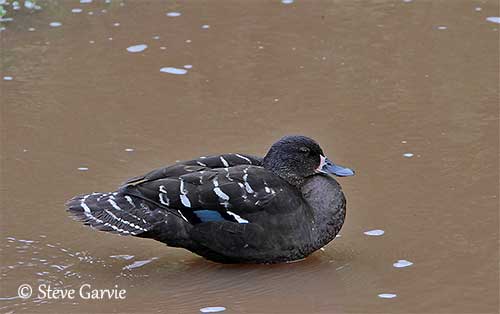
A.s. leucostigma
Kenya
A.s. sparsa (described above) is found in Namibia, E Botswana and Zimbabwe, and S through South Africa. It has greener speculum than previous race.
HABITAT:
The African Black Duck frequents wooded streams and remote rocky pools in mountainous areas. It can be seen up to 4000 metres of elevation in Kenya. In South Africa, it frequents streams and fast-flowing rivers, and less frequently ponds and dams. It can be seen locally in more open habitats.
CALLS AND SONGS: SOUNDS BY XENO-CANTO
The African Black Duck produces some “quack” especially in flight. Male and female are vocal both in flight and on water. The male utters a weak, high-pitched whistle “weep” often repeated in regular series. The female gives repeated quacking notes as contact call and while flying with the male.
Whistles usually accompany the courtship displays, but the very weak male’s call, a wheezy “peep”, is often inaudible.
BEHAVIOUR IN THE WILD:
The African Black Duck feeds on aquatic insects, crabs, crustaceans, small fish, aquatic vegetation, seed and grain crops, acorns and berries (Pyracantha).
It feeds by head dipping, immersing the whole head under water, but also by upending in shallow water and by diving too. It probes in mud or among aquatic vegetation, and searches for food around rocks in fast-moving water.
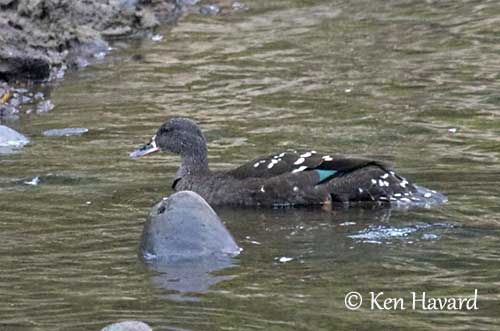
A.s. leucostigma
Ethiopia
The African Black Duck is mostly active at dawn and dusk. It usually rests up during the day, lying well-hidden and motionless at regular sites, and taking advantage of its cryptic plumage. It is often seen in pairs or family groups.
The African Black Duck is monogamous with strong pair-bond, as usual in river ducks. They perform elaborate courtship displays with diving, neck biting and various other typical Anatidae displays.
They maintain and defend a territory throughout the year, and chase away all conspecifics, including sometimes the young from the previous year.
The male plays an active role during the reproduction, guarding the incubating female, accompanying the young and defending the territory.
The African Black Duck is sedentary throughout the range and only performs short seasonal movements.
It takes off upwards from the water and then, it flies off with fast flight, usually very low over water while the wingtips almost touch the surface.
REPRODUCTION OF THIS SPECIES:
The breeding season varies according to the range.
The African Black Duck nests in single pairs. The nest is placed on the ground, very close to the water, within two metres, but usually above the flood-level. The hollow is thickly lined with down. The nest is hidden among reeds and grass on the riverbank.
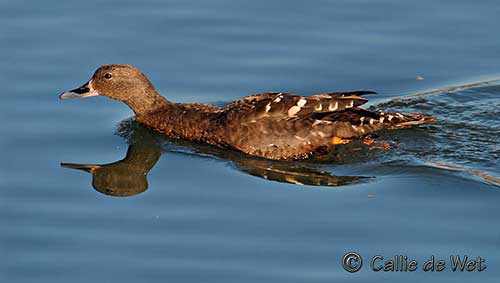
The female lays 4-9/5-7 creamy-white to buff-yellow eggs. She incubates alone during 28-32 days, guarded by the male. At hatching, the chicks have black down above and buffy-white below, with white collar on upper breast and pale yellow spots on back. The bill is black.
They leave the nest very soon after hatching, and the female leads them to the water once dry. She protects them and keeps them under the vegetal cover. The chicks feed by diving and may chase insects along the water. They are able to fly at 75-77 days old and become independent. The family may join the male at nocturnal roost.
PROTECTION / THREATS / STATUS:
The African Black Duck is threatened by deforestation in Kenya, and habitat loss through dam building involving degradation of rivers. In addition, it may sometimes hybridize with Mallard.
The nominate race “sparsa” appears to be the more widely distributed in suitable habitat, but it is considered uncommon and local in South Africa.
The population size is unknown but it is suspected to be decreasing. But currently, the African Black Duck is evaluated as Least Concern.
